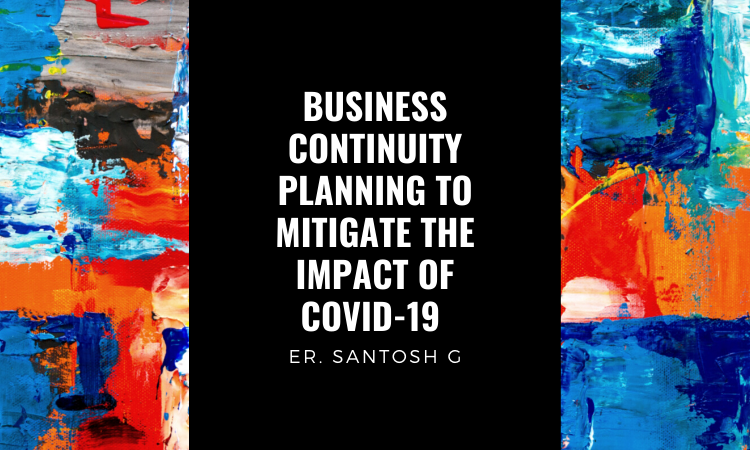
A business’s ability to keep providing goods or services to customers as usual after a disruptive incident is known as business continuity, and this is also referred to as business continuity and resiliency planning. The goal is to enable ongoing operations before and during a disaster’s recovery. The goal of proper disaster recovery and business continuity preparation is business continuity.
There are numerous business continuity standards that different standards bodies have released to assist with the checklisting of ongoing planning activities.
It is referred to as “failure resistance” when an organisation is able to bear the strains of environmental change while still continuing to function. It enables organisations to either maintain their current strategy in the face of changing environmental conditions, or be forced to alter their procedures to fit the new conditions. In common parlance, it is referred to as a type of resilience.
The supply chain disruption, the failure or destruction to critical infrastructure (major machinery or computing/network resource), or any other incident that could have a negative impact on operations, should be part of the contingency plan. Risk management is a subset of Business Continuity Planning (BCP). [8] In the United States, this process is known as continuity of operations planning (COOP). A Business Continuity Plan depicts various situations that could pose a threat to the company, as well as all the procedures the company will undertake to get back to normal operations. Pre-written BCPs contain precautionary measures that can be utilised. A BCP is a collection of contingencies that are made to deal with the risks associated with possible damage to companies when things turn out poorly. It is most often developed in conjunction with key personnel and stakeholders.
Resilence
The study of public relations is influenced by the theory of resilience. Through day-to-day talk and mediated communication, people, communities, the media system, organisations, and governments all contribute to overall resilience.
Purdue University’s communication professor, Patrice M. Buzzanell, created the theory. In her 2010 post, “Resilience: Talking, Resisting, and Imagining New Normalcies Into Being,” she sought to find out how organisations would overcome a crisis. These are five separate mechanisms that people use while attempting to preserve their own well-being, says Buzzanell.
Continuity
The main operational dependencies are disrupted, so plans and procedures are used to ensure essential organisational processes keep running. The entire organisation does not have to be in a constant state of flux. ISO 22301 (2019) states that businesses must develop a set of business continuity goals, the smallest acceptable range of product and service operation, and the maximum allowable duration of disruption (MTPD).
It requires a significant expenditure to get ready for this audit. Tools are available to save time and money on the process of manually producing this documentation.
the criticality of human factors in business continuity and disaster recovery planning has been proven for the COVID-19 pandemic’s 12+ months Due to incidents like the one we had with the Nor’easter this month, and attacks like the WannaCry ransomware incident, numerous organisations are confronted with new issues that aren’t always linked to standard disasters, such as outage- or computer virus-related incidents. Work-related illnesses, social isolation, and long-term remote work are becoming significant issues in nearly every organisation.
Businesses can adjust their BCDR plans to better accommodate human issues. To minimise the effects of COVID-19 in the future, disaster recovery teams should implement an updated pandemic business continuity plan that incorporates the obstacles presented by COVID-19.
The first step is to address the fact that all organisations now face the possibility of prolonged periods of unavailability or loss of staff. This refers to employees who work remotely as well as to employees who are no longer able to do their normal work because of a physical or mental illness. BCDR teams must have a thorough understanding of their role and responsibilities in human resource matters as well as operational matters.
Following this, pandemic recovery planning must be incorporated into BCDR plans. Business continuity plans are no longer necessary in the age of the global internet. Pandemics – or other far-reaching health-related events – can no longer be seen as isolated events.
Case study of Joyce, Kenya
A fish processing company owned by Joyce is located in Mombasa, Kenya, and produces canned sardines. Not only does she sell directly to customers in Kenya, but she also sells to exporters of Kenya’s goods. About 80% of Joyce’s company is supplied by three consistently shipping customers. Because of their ties to the export market, these companies issue daily orders. COVID-19 cases were discovered across Kenya, which spurred Joyce to create a business continuity plan (BCP). There are 30 people employed at her company.
Joyce discovered that she had a high risk profile after taking the COVID-19 Risk Assessment exam. She worked with a diverse range of vendors on a regular basis. She employed a number of people who had to work closely together. She was reliant on the port being open for the majority of her revenue. After this, the only people who bought her products were people from other Kenyan cities, so she needed reliable transportation. Once Joyce understood that she wanted a BCP, she arrived at the inescapable conclusion that she was pregnant.
Step 1: Identification of the products that are most important.
The main things that Joyce stocks are canned sardines of various kinds. There are no other sources of revenue for the company except for these goods. Her customer base is rather select. About 80% of her revenue comes from three major customers. This will have a severe impact on her company if it doesn’t provide services to these customers.
Step 2: Describe the goal you want to achieve using BCP
Her goal was to design a simple but effective system to protect her company’s “4Ps”: people, processes, finances, and partnerships. Therefore, this meant:
Maximizing physical and emotional well-being of employees; Reinstating operations as soon as possible after disruptions; and Ensuring the delivery of goods are unaffected by COVID-19 incidents.
Step 3: Evaluate the potential impact of disruptions to enterprise and workers
She took into consideration the possibility of interruptions to her crucial operations. How many production and distribution operations are required to produce and distribute her goods, and how much downtime does she tolerate: how long can key operations be interrupted before jeopardising the business’s profitability? She was able to figure out what manufacturing and distribution operations were needed as well as where the dangers were. This was done by conducting a short stakeholder mapping exercise. Key stakeholders in her market include workers, customers, suppliers, support providers, and regulatory authorities.
Employees: Joyce employs thirty people (fortunately they mostly live locally and walk to work).
Clients: She sells 80% of her products to three international companies, two of which export to other countries. 20% of the total budget remains in the Kenyan sector (15 per cent to wholesalers based in Nairobi).
Suppliers: Three different vendors rely on her. She starts with a metal (tin) producer; that company is located in Nairobi, and the company labels are printed by a Nairobi-based printing company. The most critical factor, however, is that she works with fishing cooperatives from Nairobi. Fishermen need daily contact, but all suppliers need to stay in communication as well.
Support Services: The trucking company and the security firm that she uses are included in this category.
Public utility and regulatory authorities: Such authorities include the Food Standards Agency, which grants licences, as well as the governing bodies that set health and safety standards and implement fiscal policies.
This exercise showed Joyce how critical her company’s success is to external actors, who must continue to be safe and who must also have suppliers, consumers, and business partners willing to keep doing business. She soon learned that she might go bankrupt within four to six weeks if her business was severely disrupted. If she didn’t operate her main functions, what would be the outcome? As a result, she realised that any disruption to any of the stakeholders would result in a disruption to her business.
She felt the following risks were potentially possible:
- Customer utilities’ inability to provide services (water and energy were of particular concern) and also
- Her sales decreased because of a decline in demand for her goods.
- In light of uncontrollable events, she considered the control she had over her suppliers and the control she had over some of the events in her life.
However, on the downside, she was very reliant on her suppliers, especially in terms of future government restrictions, and she had no say in the regulations. There is a plus side: increased demand for canned and tinned goods.
Step 4: Steps to safeguard her company.
Individuals
- Her ultimate goal was to cut the number of touch points in her company to one, establish a sanitation station there, and provide a protected environment for herself and her employees.
- In addition to safety and sanitation interventions, she also tested the use of traditional work methods and modified social distance standards. New work schedules will be needed as a result of this, and she spoke with the staff about that.
- She took absenteeism into consideration.
- When she was leading the overall initiative, she asked workers to volunteer for the following tasks: daily consultations with suppliers and customers to assess their situation and any changes that had occurred; and daily inspections of the points of sanitation to ensure adequate stock was always available.
- She carefully examined the policies of each of her customers and suppliers, making sure they were current on the latest regulations.
- Since she still owed money to several vendors, she kept paying in cash (such as fishermen). The facility allowed her to both receive and make payments in a digital format.
- She took steps to ensure that she had a copy of all of her data stored safely at home in case she needed to separate herself from society.
- Her findings show that canned and tinned food demand is on the rise. Better sales revenue could have been had with this opportunity. She ensured the storage space for main inventory and finished goods inventory, which is conveniently located near a five-star hotel, were refrigerated. The significant benefit of her final goods was that they had a much longer shelf life.
- She spoke with one of her key suppliers, a cooperative of fishermen who informed her that other cooperatives along the coast also had agreements with them. However, if the Mombasa region were to be compromised, alternate sources were readily available and contracts were in place to allow this.
- Her day-to-day operational costs (payroll, rent, equipment, and so on) were tallied, and scenarios were developed for major disruptions to the company’s finances.
- She continued to keep tabs on the financial institution that had given her a line of credit on a regular basis. It was no secret that she employed a “BCP strategy”, and as a result, the bank became more open to making additional loans if that was what was needed.
Collaborations
- She had three of her key customers (exporters) meet with her to discuss it. To gather stakeholders and obtain assurances from the government that the port facilities will remain operational, she proposed that they involve the Federation of Kenyan Employers and other business groups.
- To discuss their procedures and practises, she met with four other small-business owners. In the end, they agreed on a standard procedure collection to ensure that the employees were safe. The cost of information about how to deal with issues such as shift shifts, potential layoffs, and other HR issues was divided amongst all participants.
- After reading about the tax deferrals in the newspapers, she talked to the tax authorities about it.
Step 5: Compile a list of key contacts.
- Included were important phone numbers (police, ambulance services, firefighters, hospitals, insurance companies) for officials and third parties who could be of assistance in an emergency.
- She compiled a list of everyone she works with, including their job titles, contact information (phone and email), and emergency contact information, and compiled a list of everyone she does business with, including the individual’s job title, contact information (phone and email), and business address.
- After the COVID-19 crisis hit, she created a staff emergency call tree and chose methods to contact her staff in the event of a problem (Facebook, WhatsApp, Google forms). After the COVID-19 crisis hit, she created a staff emergency call tree and chose methods to contact her staff in the event of a problem (Facebook, WhatsApp, Google forms).
Step 6: The aim is to record, verify, and correct BCP on a regular basis.
- Adopt new strategies each week.
- Modify the goal of her BCP, and improve the effectiveness of the procedures in the BCP. Also, review her risk management, business continuity plans, and other procedures in the BCP.






